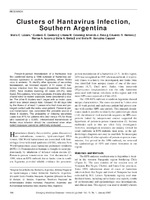Please use this identifier to cite or link to this item:
http://sgc.anlis.gob.ar/handle/123456789/530| DC Field | Value | Language |
|---|---|---|
| dc.contributor.author | Lazaro, María Ester | es |
| dc.contributor.author | Cantoni, Gustavo | es |
| dc.contributor.author | Calanni, Liliana | es |
| dc.contributor.author | Resa, Amanda J. | es |
| dc.contributor.author | Herrero, Eduardo | es |
| dc.contributor.author | Iacono, Marisa A. | es |
| dc.contributor.author | Enria, Delia | es |
| dc.contributor.author | Cappa, Stella M. González | es |
| dc.date.accessioned | 2013-07-23T01:11:40Z | - |
| dc.date.available | 2013-07-23T01:11:40Z | - |
| dc.date.issued | 2007 | - |
| dc.identifier.issn | 1080-6059 | - |
| dc.identifier.uri | http://sgc.anlis.gob.ar/handle/123456789/530 | - |
| dc.description | Fil: Lazaro, María Ester. Hospital Zonal Bariloche; Rio Negro, Argentina. | es |
| dc.description | Fil: Cantoni, Gustavo. Unidad Regional de Epidemiología y Salud Ambienta; Rio Negro, Argentina. | es |
| dc.description | Fil: Calanni, Liliana. Hospital Castro Rendón; Neuquén, Argentina. | es |
| dc.description | Fil: Resa, Amanda J. Hospital de área El Bolsón; Rio Negro, Argentina. | es |
| dc.description | Fil: Herrero, Eduardo. Unidad Regional de Epidemiología y Salud Ambienta; Rio Negro, Argentina. | es |
| dc.description | Fil: Iacono, Marisa A. Hospital Castro Rendón; Neuquen, Argentina. | es |
| dc.description | Fil: Enria, Delia. ANLIS Dr.C.G.Malbrán. Instituto Nacional de Enfermedades Virales Humanas; Argentina. | es |
| dc.description | Fil: Cappa, Stella M. González. Universidad de Buenos Aires; Argentina. | es |
| dc.description.abstract | Person-to-person transmission of a hantavirus was first confirmed during a 1996 outbreak of hantavirus pul- monary syndrome in southern Argentina, where Andes virus is endemic. To identify other episodes of secondary transmission, we reviewed reports of 51 cases of han- tavirus infection from this region (November 1993–June 2005). Nine clusters involving 20 cases (39.2%) were found. Two patients, who had symptoms 3 weeks after they shared risks for rodent exposure, were considered a clus- ter. The other 8 clusters each began with an index case, which was almost always fatal, followed 19–40 days later by the illness of at least 1 person who had close and pro- longed contact with the index case-patient. Person-to-per- son transmission was considered the probable source of these 8 clusters. The probability of initiating secondary cases was 41% for patients who died versus 4% for those who survived (p = 0.005). Interpersonal transmission of Andes virus infection should be considered even when rodent exposure cannot be definitively excluded. | es |
| dc.language.iso | en | es |
| dc.relation.ispartof | Emerging infectious diseases | es |
| dc.rights | Open Access | en_US |
| dc.rights | Creative Commons Attribution 4.0 International License | - |
| dc.rights.uri | https://creativecommons.org/licenses/by/4.0/ | - |
| dc.source | Emerging Infectious Diseases, 2007, 13(1), 104-110. | en_US |
| dc.subject | Hantavirus | es |
| dc.subject | Infecciones por Hantavirus | es |
| dc.subject | Argentina | es |
| dc.title | Clusters of Hantavirus Infection, Southern Argentina | es |
| dc.type | Artículo | es |
| dc.identifier.doi | https://dx.doi.org/10.3201%2Feid1301.060404 | - |
| anlis.essnrd | 1 | - |
| item.openairetype | Artículo | - |
| item.grantfulltext | open | - |
| item.languageiso639-1 | en | - |
| item.openairecristype | http://purl.org/coar/resource_type/c_18cf | - |
| item.fulltext | With Fulltext | - |
| item.cerifentitytype | Publications | - |
| Appears in Collections: | Preproducción Publicaciones INEVH | |
Files in This Item:
| File | Description | Size | Format | |
|---|---|---|---|---|
| EmergingInfectiousDiseases,2007,13(1),104-110..pdf | 274.98 kB | Adobe PDF |  View/Open |
Page view(s)
154
checked on Dec 4, 2025
Download(s)
78
checked on Dec 4, 2025
Google ScholarTM
Check
Altmetric
Altmetric
This item is licensed under a Creative Commons License


